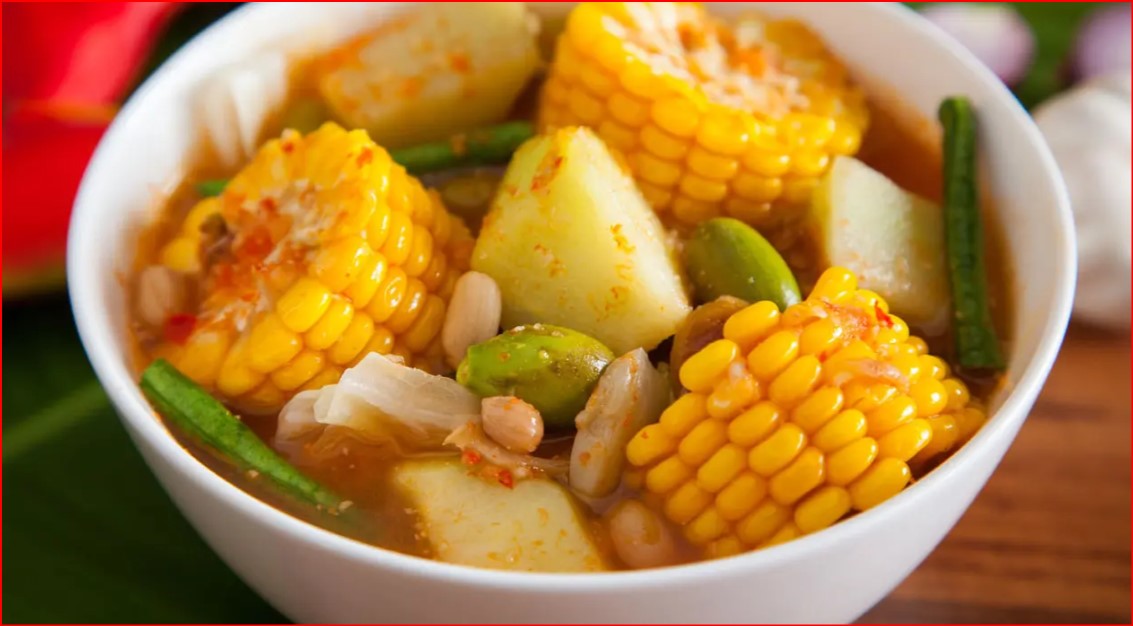Kapanlagi.com - Sundanese cuisine is a tempting culinary offering from the land of West Java. With a dominant sweet flavor and vegetable-based ingredients, this cuisine provides unforgettable deliciousness. Who doesn't know iconic dishes like sayur asem, pepes, empal gepuk, seblak, and batagor? All of these can be easily found in various corners of the region.
But don't be mistaken! Sundanese food is not only sweet, but it is also rich in varied flavors that will definitely make you addicted. The uniqueness and deliciousness of this specialty from West Java have reached all over Indonesia, so you can easily find seblak, batagor, sate maranggi, and lotek even in places far from their origin.
For those of you who are curious, here is a summary of 25 Sundanese dishes that you must try. Get your taste buds ready to experience unparalleled deliciousness!
1. Sundanese Specialties

Pepes
The first Sundanese specialty is pepes. Pepes is a cooking technique commonly found in various regions in Indonesia, rather than the name of a dish. Pepes typically consists of food items like fish, tofu, mushrooms, and other ingredients. The cooking method involves wrapping the ingredients in banana leaves, then steaming or grilling them until cooked. This dish is then seasoned with selected spices that are processed by grinding. Pepes is best served with warm rice and sayur asem.
Seblak
Seblak is a Sundanese dish known for its spicy flavor. The main ingredient of seblak is crackers that are boiled with spicy kencur seasoning, then topped with a variety of selected toppings, such as chicken feet, macaroni, meatballs, sausages, chicken, and more.
Karedok
Karedok is a unique Sundanese dish in terms of preparation. Karedok is served with raw and unprocessed vegetables. Karedok has a unique taste due to the combination of kencur and peanut sauce that come together. The vegetables used to make karedok are quite diverse, such as cucumber, bean sprouts, legumes, small green eggplant, cabbage, basil, and several other types of vegetables that can be added according to the maker's preference.
Nasi Timbel
This Sundanese specialty has a strong and unique flavor. Nasi timbel is usually wrapped in banana leaves. It is accompanied by various side dishes to complement the fluffy nasi timbel, such as salted fish, pepes fish, empal, fried chicken, and japuh. It is then complemented with lalapan and sambal to enhance its traditional value.
Surabi
Surabi is a traditional Sundanese food made from rice flour dough that is cooked on a stove. In Bandung, serabi is usually sold in the morning and cooked using a stove, resulting in a distinctive taste.
2. Sundanese Specialties

Nasi Tutug Oncom
This traditional Sundanese dish consists of rice mixed with fried or grilled oncom. The process of mixing and pounding rice with oncom in Sundanese is known as tutug oncom. Nasi tutug oncom can be served with side dishes such as fried tofu, fried tempeh, fried chicken, vegetable salad, and sambal terasi.
Empal Gentong
Empal gentong or beef curry is served with lontong or rice. This specialty from Cirebon, West Java is usually served with chives and sambal made from ground dried shrimp. The flavor produced by the beef is very special, which is understandable because of the essence of the empal spices that are embedded in the pot.
Peuyeum
Peuyeum is a very famous traditional Sundanese food. This dish is quite similar to tape found in other regions, but peuyeum is more watery and somewhat runny. Besides being made with cassava, there is also peuyeum made from fermented glutinous rice, like most peuyeum found.
Colenak
Colenak is a dish made from grilled peuyeum that is enjoyed by dipping it in liquid brown sugar mixed with grated coconut. This food is a legendary traditional Sundanese dish.
Ongol-Ongol
Ongol-ongol cake is categorized as a unique traditional Sundanese food. This cake is cube-shaped and coated with grated coconut, and it is a must-try if you visit the northern part of West Java, such as Indramayu and Cirebon. Ongol-ongol is a cake with a chewy texture, sweet, savory, and brown in color. The main ingredients for making ongol-ongol cake are cassava flour and hunkue.
3. Sundanese Specialties

Nasi Liwet
Nasi liwet has two versions. The first version comes from Solo, while the second version comes from Sunda. The difference between the two is that in Solo, the nasi liwet is made with coconut milk and served with pumpkin cooked in coconut milk. The Sundanese version does not use coconut milk in the cooking process.
The savory flavor is obtained from the use of typical Indonesian spices such as lemongrass, bird's eye chili, shallots, garlic, salted fish, basil leaves, and bay leaves. Usually, nasi liwet is enjoyed with salted fish.
Sayur Asem
This traditional Sundanese dish is called sayur asem because it uses tamarind to give a sour taste to the broth. The vegetables used include pumpkin, corn, long beans, young jackfruit, starfruit, melinjo, and peanuts. Sayur asem is even more delicious when enjoyed with warm rice and side dishes like salted fish and sambal.
Basreng
Basreng or fried meatballs are a traditional Sundanese food that is certainly familiar to many people. This food is made from thinly sliced beef or chicken meatballs that are fried. Usually, basreng is sprinkled with spicy seasoning.
Lotek
Lotek is a typical Sundanese dish that resembles gado-gado. Lotek is made from boiled spinach, carrots, and chayote, and is topped with peanut sauce made from peanuts, garlic, kencur, tamarind water, brown sugar, and salt.
Mi Kocok
Mi kocok is a unique Sundanese dish due to its preparation. It is made from yellow noodles, bean sprouts, meatballs, and kiki, served with beef broth. Usually, mi kocok is served with added celery leaves, green onions, and fried shallots. This noodle is cooked by shaking the noodles in a special container while dipping it into hot water.
4. Sundanese Specialties

Bakakak Hayam
This traditional Sundanese dish is made with chicken as the main ingredient, seasoned with special Sundanese spices, and cooked by roasting. It is served as a whole chicken accompanied by two types of sambal, such as red sambal and green sambal. In addition to sambal, bakakak hayam is even more special when enjoyed with a side of fresh vegetables. Perfect for sharing.
Empal Gepuk Daging
This dish is made from thin slices of beef that are pounded until flat. Then it is cooked with a sweet seasoning. Once the beef is flattened and seasoned, it is simmered until the spices are absorbed. When it is tender and the spices have penetrated, empal is fried until dry or can also be enjoyed immediately without frying again. Empal gepuk is even more delicious when eaten with warm rice, fresh vegetables, and shrimp paste sambal.
Batagor
Batagor or fried tofu meatballs is a traditional Sundanese dish that is usually eaten with chili sauce and peanut sauce. Batagor is very popular and may have spread throughout Indonesia. You can easily find it in front of schools.
Sate Maranggi
Sate maranggi is a traditional Sundanese dish that is equally popular. This satay is simply drizzled with soy sauce and served with pickled tomatoes and chili. The meat in Sate Maranggi is usually marinated with shallots, garlic, salt, coriander, and tamarind water. Some also wrap the meat in papaya leaves to make it more tender.
Jojorong
Jojorong is a traditional Sundanese food that is addictive. Jojorong cake is made from starch flour, rice flour, and filled with liquid brown sugar. At first glance, this sweet snack looks like pudding but is softer with the addition of coconut milk on top. The texture of jojorong cake is wet and sticky. This texture makes jojorong not last long. If made in the morning, jojorong cake can only last until the afternoon at room temperature.
5. Must-Try Sundanese Specialties

Cungkring
Cungkring is a unique culinary dish from Bogor. The name cungkring is usually associated with a very thin person, whereas in the rainy city, it refers to a dish that is becoming rare. Cungkring itself is an abbreviation of "Cingur" and "Kaki Garingan". True to its name, a serving of cungkring contains pieces of cingur or cow's nose, kikil, and fried snacks drenched in peanut sauce.
Toge Goreng
Still from the rainy city of Bogor, there is another unique and legendary dish called toge goreng. This food is legendary throughout Bogor, filled with boiled bean sprouts mixed with yellow noodles, yellow tofu, and ketupat. Finally, this dish is served with peanut sauce mixed with dage or fermented soybeans.
Nasi Lengko
Moving to the north of West Java, there is another addictive culinary dish called nasi lengko. This food originates from Indramayu Regency, parts of Majalengka, and the entire Cirebon region (city and regency). Lengko rice contains fresh bean sprouts, slices of fried tempeh and tofu, sprinkled with chives and fried shallots. Finally, lengko rice is topped with savory peanut sauce and authentic local soy sauce.
Jamblang Rice
In Cirebon, Jamblang rice or nasi Jamblang is also very famous. The uniqueness of this dish lies in the variety of side dishes that reach dozens. Starting from salted jambal fish, corn fritters, omelets, black squid, stewed tofu, spicy eggs, fried brains to various offal filling the bowls in the stalls. Lengko rice is very delicious when enjoyed with rice wrapped in teak leaves, crispy fried tempeh, and red chili sauce.
Geco Cianjur
In Cianjur, there is a unique culinary dish called geco or oncom bean sprouts. This food consists of pieces of ketupat, yellow noodles, fresh bean sprouts, tofu, and a savory sour spicy oncom broth, which is fermented soybeans. This dish is very delicious and can be enjoyed for lunch or dinner.
(kpl/srr)
Disclaimer: This translation from Bahasa Indonesia to English has been generated by Artificial Intelligence.

















